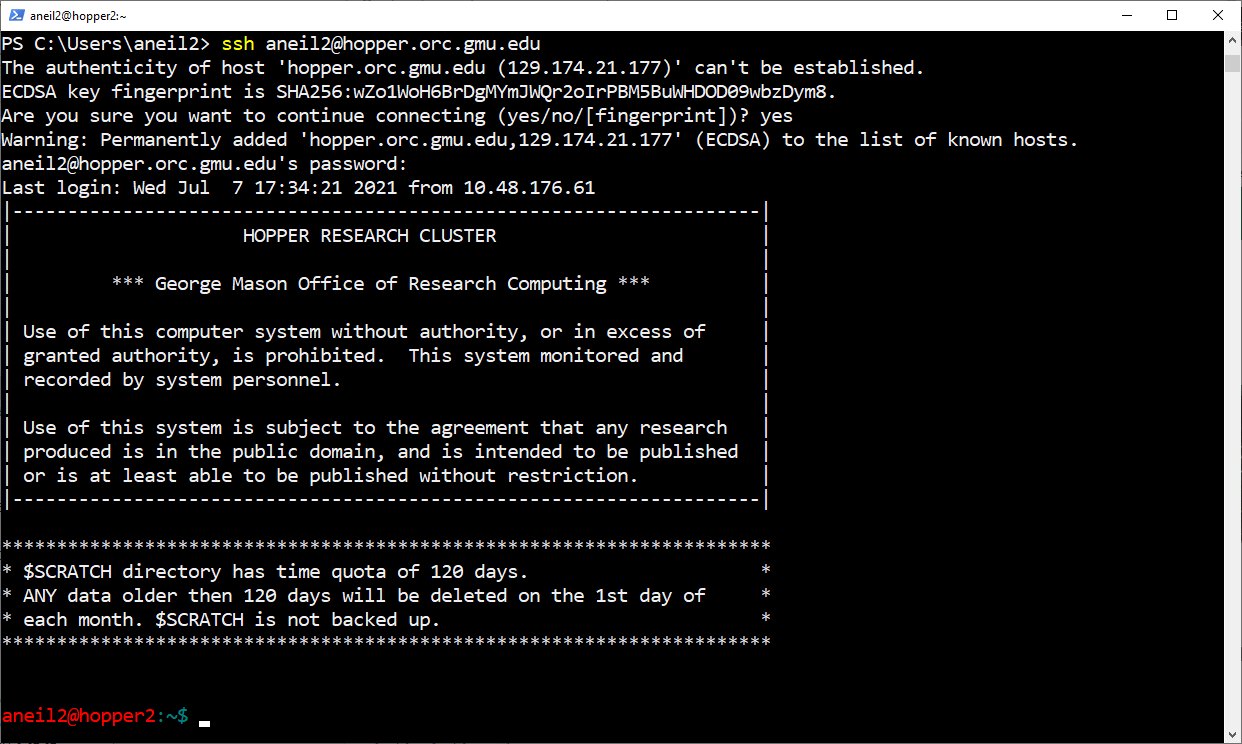Logging into Hopper

Users may access Hopper via SSH remote login to the host
hopper.orc.gmu.edu with their GMU netID and password.
This method provides you with a UNIX shell session on one of Hopper's head nodes. Currently,
the GMU VPN is required in order to access the cluster. If you are not on the GMU VPN you can get connected by using the Duo Multifactor Authentication.
Alternatively, users may access Hopper via a web based interface called Open OnDemand, more details on accessing Open OnDemand can be found on the wiki page: Open OnDemand on Hopper.
Connecting via SSH
To connect to Hopper use the following command from a terminal on your local system:
ssh your-gmu-user-id@hopper.orc.gmu.edu
where your-gmu-user-id is your GMU
netID.
All current, popular operating systems provide a terminal and support SSH remote login. This includes Windows, although users of Windows prior to version 10 will need to install a third-party ssh client (e.g. PuTTY.)
Once the you have entered the above command you will be prompted to authenticate by entering your GMU password. When authentication is successful you will be logged in to one of the Hopper cluster head nodes (hopper1 or hopper2). If you don't have access, please see Getting an ORC Cluster Account.
Duo Multifactor Authentication
Connecting to the headnodes of Hopper from off-campus connections requires Multifactor authentication using Duo. Users may wish to use a VPN connection to the campus network in order to prevent the necessity for additional Multifactor authentication. Be sure to select the correct VPN group, however frequently the GENERAL vpn group is sufficient to connect to Hopper.
Passwordless SSH
You may wish to create an ssh key-pair to provide alternative authentication. To do this, first open a terminal on your local computer. Then run
ssh-keygen -t ed25519
scp .ssh/id_ed25519.pub username@hopper.orc.gmu.edu:
ssh hopper.orc.gmu.edu -l username #SSH to Hopper
mkdir .ssh
cat id_ed25519.pub >> .ssh/authorized_keys
Subsequent connections to hopper should now use the SSH key-pair for authentication and will no longer prompt you for a password.
X-Forwarding
To use program with a GUI natively, users of Mac or Unix/Linux systems may wish to use either or -X or -Y (recommended) X11 forwarding options. For details on how these and other advanced options work, you can visit the ssh manual page: SSH manual.
See Also
Once logged in, jobs on the cluster may be scheduled via the Slurm resource manager. The nodes themselves are not directly accessible -- all node access is controlled through Slurm.